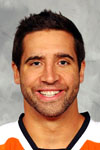 POST-SERIES FALLOUT: 5 THOUGHTS
POST-SERIES FALLOUT: 5 THOUGHTS
 1 EXPECTATIONS – When a team regarded as a Cup favorite by ownership is eliminated in the first round and hasn’t advanced past the second round since 2009, it’s going to lead to a rumor filled summer, but it’s way, way too early to predict whether the Penguins might look to make a major shakup. “Expectations for our team is high, and no matter what your season looks like, the expectation was very high with this group and getting Sidney back with 14 games and to have a full compliment with players, with what this group has done, could have even set the expectations higher, ” head coach Dan Bylsma said. “There’s not a lot of words to describe this group, expectations, and what we thought with this compliment of players, ” he said
1 EXPECTATIONS – When a team regarded as a Cup favorite by ownership is eliminated in the first round and hasn’t advanced past the second round since 2009, it’s going to lead to a rumor filled summer, but it’s way, way too early to predict whether the Penguins might look to make a major shakup. “Expectations for our team is high, and no matter what your season looks like, the expectation was very high with this group and getting Sidney back with 14 games and to have a full compliment with players, with what this group has done, could have even set the expectations higher, ” head coach Dan Bylsma said. “There’s not a lot of words to describe this group, expectations, and what we thought with this compliment of players, ” he saidWhat I’d expect from Penguin management is a long evaluation process and they have to look closely at several areas from personnel, to how they evaluate players and even the system in place from Dan Bylsma has to be examined on how the Penguins defend.
 2 STAAL’S FUTURE – Aside from a Game 1 defensive blunder on Jakub Voracek’s overtime winner in Game 1, Jordan Staal was the Penguins best forward in the series, being a consistent force offensively and leading the Penguins with 6 goals, 9 points and 8 even strength points in the series.
2 STAAL’S FUTURE – Aside from a Game 1 defensive blunder on Jakub Voracek’s overtime winner in Game 1, Jordan Staal was the Penguins best forward in the series, being a consistent force offensively and leading the Penguins with 6 goals, 9 points and 8 even strength points in the series.Staal’s future though with the Penguins is already and going to be a hot topic all summer. “I don’t wonder about it, ” Staal said following Game 6. “I love the guys in this room and I believe in everyone of the guys in this room. We have the character in this room and we didn’t give up in this series, just too bad we came up short. “It’s never easy to take, no matter what year, ” Staal said on the loss. “Not a good feeling but guys are definitely going to remember this feeling, hopefully take something positive out of it and do what we can next season.”
Here’s what to know about Staal: The Penguins are said to remain fully committed to trying to lock up Staal long-term as negotiations between the two sides can’t begin until July 1 and while league executives believe Staal is a $7 million a year player, whether Staal is a Penguin long-term is going to depend on whether Staal wants to explore a No. 1, No. 2 center role and top power play role or not as I wrote in March. That’s what individuals inside the Penguins organization believe it’s going to come down to. The Penguins know and are prepared to make Staal a $6+ million a year player, sources say.
If the Penguins ever reach the point of willing to explore Staal’s trade value, it’s going to be because they feel he fully intends on exploring the open market next July. Trading Staal would likely not involve immediate impact players coming the other way, most notably a No. 1 type defenseman as any team who trades for Staal would want a long-term commitment before giving away a significant haul of NHL ready players. It would be a big surprise if the Penguins looked to move Staal this summer.
 3. COUTURIER SHUTTING DOWN MALKIN – Evgeni Malkin had 8 points in the series and while those are respectable numbers, it never felt like Malkin was ever an impact player in the series, except in Game 4 when he scored a crucial turning point goal late in the first period of that particular game.
3. COUTURIER SHUTTING DOWN MALKIN – Evgeni Malkin had 8 points in the series and while those are respectable numbers, it never felt like Malkin was ever an impact player in the series, except in Game 4 when he scored a crucial turning point goal late in the first period of that particular game.19 year old Sean Couturier, the Flyers 2011 first round pick, frustrated and shutdown Malkin limiting him to just 4 even strength points in the series. 19 year olds aren’t suppose to shutdown MVP’s of the league. The Flyers have a special player in Couturier and we also saw in this series that none of the Penguins stars were able to match the dominant play Claude Giroux put forth.
 4 TALBOT – Money played a part in Max Talbot signing the with the Philadelphia Flyers this past summer but no one can say he made the wrong decision from how he fits in with the Flyers style.
4 TALBOT – Money played a part in Max Talbot signing the with the Philadelphia Flyers this past summer but no one can say he made the wrong decision from how he fits in with the Flyers style.Talbot was a major factor in the series with 3 goals, 1 assist and a +5 rating, while averaging 17:53 of ice time, including 4:01 of ice time shorthanded, which ranked 1st among Flyers forwards. Talbot who had two shorthanded goals in the series, has a lot of trust from head coach Peter Laviolette who relies heavily on Talbot in key situations, such as in a shutdown role and on the penalty kill. His last two years in Pittsburgh, Talbot was viewed more as a 4th liner by Bylsma.
 5 FLYERS EDGE – Why the Flyers won in six games is because of a lot of factors but the Flyers had the edge in FOUR KEY AREASÂ “Scoring”, “Team Defense”, “Goaltending” and “Special Teams”.
5 FLYERS EDGE – Why the Flyers won in six games is because of a lot of factors but the Flyers had the edge in FOUR KEY AREAS “Scoring”, “Team Defense”, “Goaltending” and “Special Teams”.The biggest edge Philadelphia had was on special teams where their power play was potent, going 12-23, clicking at 52.2% and Pittsburgh just had no answers, most notably for Claude Giroux who the Flyers top power play unit goes through. In Game 6, the Penguins never learned their lesson and on Scott Hartnell’s rebound power play goal in the first period, Pittsburgh had three players collapse to the right side, leaving Giroux wide open on the left side to one time a cross-ice pass and Hartnell put in the rebound. Why the Penguins failed at making adjustments in the series and have struggled on the PK for three straight post-seasons, despite success in the regular season, is a mystery.
The Penguins were 47.8% on the PK and are now just 69% on the penalty kill in their last 26 playoff games.
Where the Flyers also held a size-able edge was with “Team Defense” as they were able to tighten things up and lock down defensively in key situations, and unlike the Penguins, they did an excellent job at blocking shots and making things easier on their goaltender.
The goaltending was shaky for both teams but the Flyers ended up having a sizeable enough edge where it was a big difference in the series. As bad as Ilya Bryzgalov was at times and while he never had a Marc Andre Fleury Game 5 type of performance, Bryzgalov came up with more timely saves and didn’t let up those “killer goals” that Fleury did on a consistent basis, which popped up once again today on Erik Gustafsson’s second period goal.
Bryzgalov was 4-2 in the series with a 3.89 GAA and .871 save percentage. Fleury who is 2-8 in his last 10 playoff games, was 2-4 in the series with a 4.63 goals against average and .834 save percentage. Fleury was not good enough in this series as he hasn’t been the past three post-seasons.
NOTABLE SERIES GRADES (A’s & B+)
Grade A
PHI C Claude Giroux (6 goals – 8 assists – 14 pts – +6 – 21:39 TOI – 51.4 FO%)
Analysis: Was the best player in the series and not much needs to be said.
PHI C Sean Couturier (3 goals – 1 assist – 4 pts – +3 – 17:17 TOI – 57.0 FO%)
Analysis: Played a shutdown role against Evgeni Malkin and frustrated the likely Hart Trophy winner, and was also a factor offensively, scoring a hat trick in Game 2.
PHI D Braydon Coburn (0 goals – 4 assists – 4 pts – +3 – 27:49 TOI – 17 Hits – 13 Blocked Shots)
Analysis: Played a shutdown role against the Penguins top line of Evgeni Malkin, Chris Kunitz and James Neal, and logged heavy minutes for a Flyers defensive corps that was missing a number of regulars.
Grade B+
PIT C Jordan Staal (6 goals – 3 assists – 9 pts – +2 – 19:49 TOI/G – 49.5 FO%)
Analysis: Was the Penguins most dominant offensive player in the series, leading the team with 6 goals and 9 points, including 8 even strength points and was a constant factor in the offensive zone. Defensively, had a bad blunder in Game 1 on Voracek’s overtime goal and was inconsistent on the PK though.
PHI C Danny Briere (5 goals – 3 assists – 8 pts – -5 – 15:27 TOI/G – 50.0%)
Analysis: Was a liability at times defensively even strength but from an impact standpoint, there wasn’t a better player on the ice in Game 1 and Briere was excellent in Game 3 and overall had 5 goals and 8 points in the series.
PHI RW Jakub Voracek (2 goals – 5 assists – 7 points – +1 – 14:24 TOI/G)
Analysis: Scored the overtime winner in Game 1 and was a huge factor with his speed at both ends of the ice, in addition to working the right half boards on the first power play unit and his game is coming around very nicely.
PHI RW Max Talbot (3 goals – 1 assist – 4 pts – +5 – 17:53 TOI)
Analysis: Scored 2 shorthanded goals and impacted the series in several areas. Logged the highest average among forwards shorthanded at 4:01 per game and was a constant threat shorthanded to score with Claude Giroux working as Philadelphia’s No. 1 PK pair.
